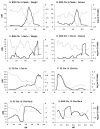Genetic control of the mouse cerebellum: identification of quantitative trait loci modulating size and architecture
- PMID: 11438585
- PMCID: PMC6762866
- DOI: 10.1523/JNEUROSCI.21-14-05099.2001
Genetic control of the mouse cerebellum: identification of quantitative trait loci modulating size and architecture
Abstract
To discover genes influencing cerebellum development, we conducted a complex trait analysis of variation in the size of the adult mouse cerebellum. We analyzed two sets of recombinant inbred BXD strains and an F2 intercross of the common inbred strains, C57BL/6J and DBA/2J. We measured cerebellar size as the weight or volume of fixed or histologically processed tissue. Among BXD recombinant inbred strains, the cerebellum averages 52 mg (12.4% of the brain) and ranges 18 mg in size. In F2 mice, the cerebellum averages 62 mg (12.9% of the brain) and ranges approximately 20 mg in size. Five quantitative trait loci (QTLs) that significantly control variation in cerebellar size were mapped to chromosomes 1 (Cbs1a), 8 (Cbs8a), 14 (Cbs14a), and 19 (Cbs19a, Cbs19b). In combination, these QTLs can shift cerebellar size an appreciable 35% of the observed range. To assess regional genetic control of the cerebellum, we also measured the volume of the cell-rich, internal granule layer (IGL) in a set of BXD strains. The IGL ranges from 34 to 43% of total cerebellar volume. The QTL Cbs8a is significantly linked to variation in IGL volume and is suggestively linked to variation in the number of cerebellar folia. The QTLs we have discovered are among the first loci shown to modulate the size and architecture of the adult mouse cerebellum.
Figures




References
-
- Alder J, Lee KJ, Jessell TM, Hatten ME. Generation of cerebellar granule neurons in vivo by transplantation of BMP-treated neural progenitor cells. Nat Neurosci. 1999;2:535–540. - PubMed
-
- Barton RA, Harvey PH. Mosaic evolution of brain structure in mammals. Nature. 2000;405:1055–1058. - PubMed
-
- Butler W, Hodos AB. Comparative vertebrate neuroanatomy: evolution and adaptation. Wiley; New York: 1996.
-
- Cooper PA, Benno RH, Hahn ME, Hewitt JK. Genetic analysis of cerebellar foliation patterns in mice (Mus musculus). Behav Genet. 1991;21:405–419. - PubMed
Publication types
MeSH terms
Grants and funding
LinkOut - more resources
Full Text Sources
Molecular Biology Databases
Miscellaneous
